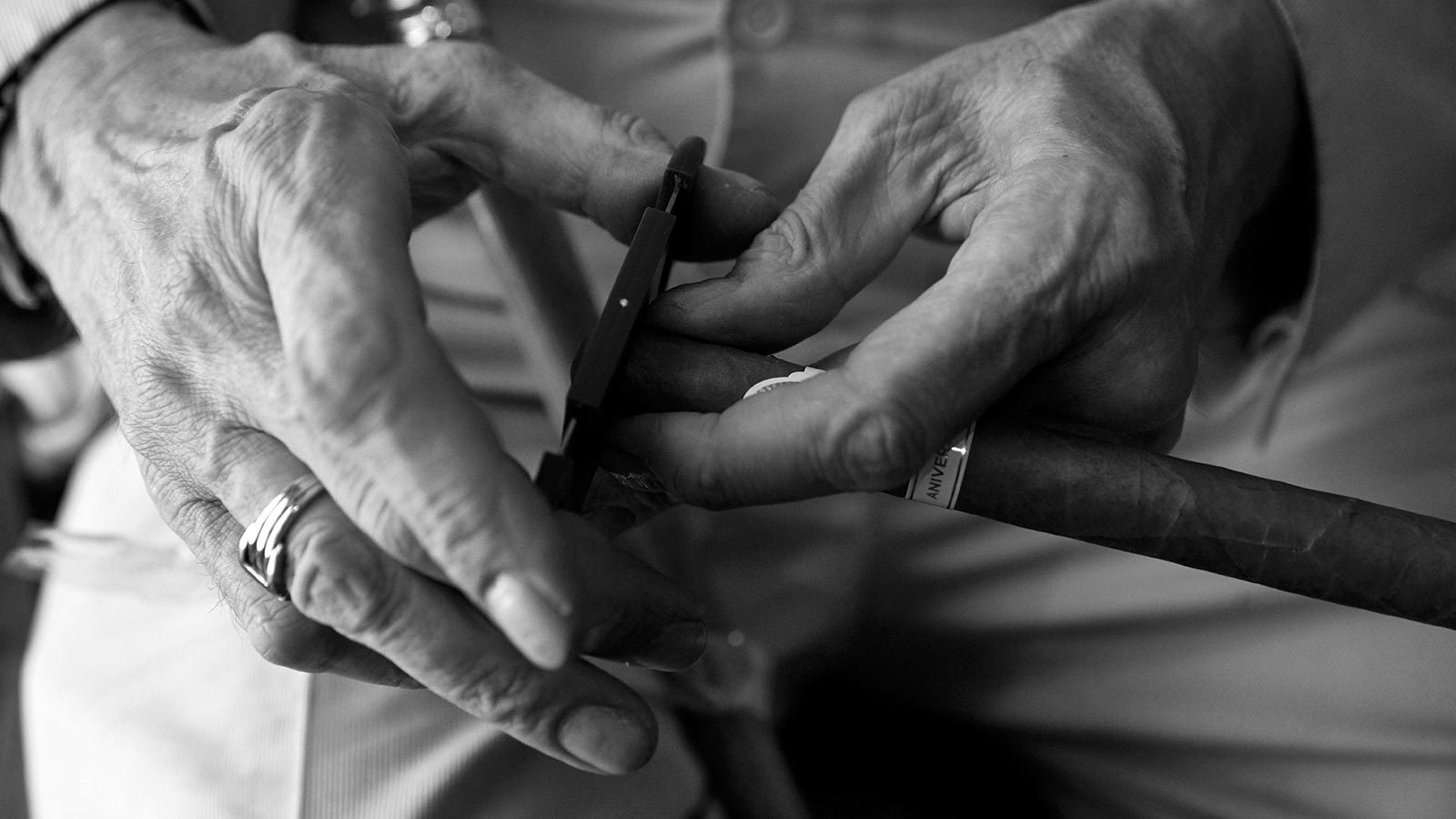
George Liggett keeps tobacconist traditions alive at The Nostalgia Shop.
By the time he was a teen, he was beyond proficient. “I hand-rolled my grandfather’s 100 cigarettes every Sunday,” George says. “Back in the day, there were no chemicals in cigarettes, so that was my job, and that’s why I’ve always been around tobacco and always enjoyed it.”
It wasn’t just for pleasure, though; his grandfather was in the business of supplying tobacco to drug stores along the stretch of Highway 40, now Interstate 70, from St. Louis to Wichita.
Today, George is not much for cigarettes, which now harbor too many harmful chemicals. But he is quite fond of tobacco. He prefers cigars, and fine ones. The boyhood tobacconist has aged into a tall man who wears a suit and walks with a brass skull-capped cane. You’d be hard pressed to find him without a cigar in his hand, but it’s not always lit. He caps his intake at one a day, if that. “It’s like an orchestra conductor — I’ve gotta have my baton,” he says. George conducts the operations at The Nostalgia Shop, where, following in his grandfather’s footsteps, he dabbles in the business of tobacco. “This is my 51st year in the business,” he says. “I grew up with it.”

The Golden Trio
But George is not only a tobacconist; he’s a collector. The inventory in his shop reflects his deep appreciation for life’s finer things, especially a particular golden trio: cigars, antiques, and really good hooch.
For more than half a century, he’s traveled from coast to coast seeking out fine selections to share with his fellow collectors and connoisseurs in his shop, the last cigar lounge in Columbia. “The thing about antiques and antiquities: the people that collect antiques and invest in them, they also drink good wine, drink good spirits, eat good food, and visit us,” he says. “It all kind of dovetails together.”
Every so often, George dips a stunted, slender slat of wood into the flame of a candle, and brings it up to the foot of his cigar. “These are Spanish Cedar strips,” he says. He explains that cigars are packed in layers within boxes, and thin sheets of Spanish Cedar are used to separate them.
“Most tobacconists throw it away, but I break it into pieces. It’s cheaper than matches, and I don’t want to waste it either.” George will keep you captivated with these tidbits of information, and before you know it, minutes have turned into hours. He has an extensive catalog of memories; he smoothly rattles off stories about meeting and working with big names at antique and cigar shows: Freddy Mercury, Hugh Hefner, Bob Kane, and Jay Silverheels are just a few. He’ll tell you that it’s his work with antiques, specifically for a Smithsonian project, that got him involved in selling cigars and liquor.
“As we were buying all the antiques at the shows, I met all these politicians who were sponsors,” he says. “They would find their antiques and then would say, ‘You know, if you go out to California, can you find some wine for me?’’’
He’d found a niche. “Back then, California could only do intrastate not interstate shipping, so I’d go out there and bring it back to D.C. Then it went from fine wines to Kentucky with bourbons; then one day a guy comes up to me, and he said, ‘Can you get this cigar for me?’ and it just all went together. So here I was, delivering the whole gambit, which goes right along with the antique resale.”
But it all goes back to those long-ago Sundays spent rolling cigarettes. “This is the heartbeat of the whole business, the tobacco,” George says. “This is the destination point.”
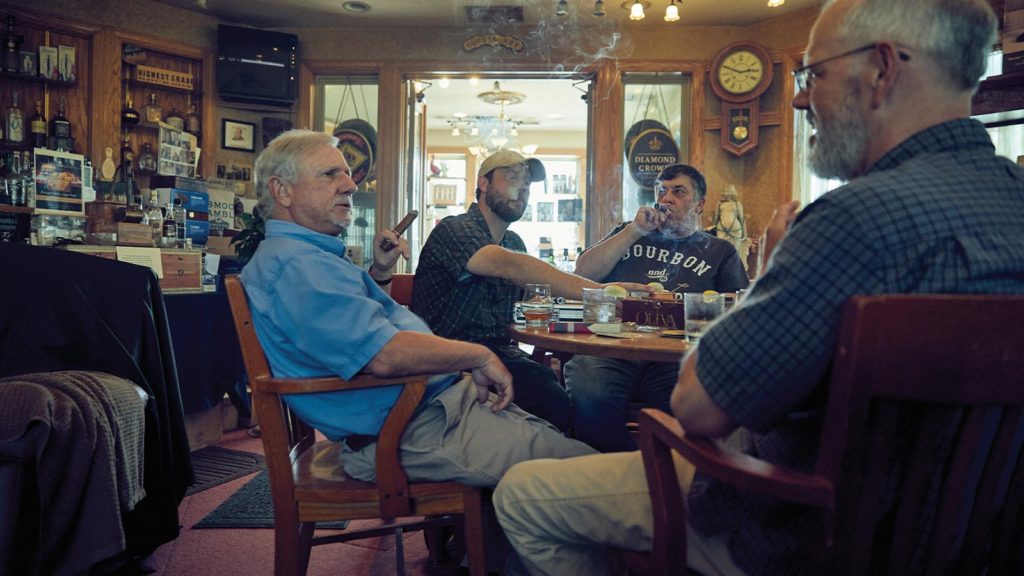
Lane Clarke, Andrew Burruk, Marc Weichelt, and Tom Quinn.
The Finer Things
He shows me inside the humidor where all his cigars are stored. It’s a temperature-controlled room set at 70 degrees and designed specifically for this purpose. A soft brick floor, laid with bricks from an old Stephens College building, holds just the right amount of moisture, at least 70%. Moisture is a key component; if a cigar dries out, it’s no good. “I water it every night before I leave,” George says.
As the night goes on it absorbs the humidity: It percolates to the ceiling and the fans knock it back down and it keeps the cigars perfectly fresh. A particular set of wood shelves lines the walls inside the humidor. “The only thing a cigar won’t take the flavor of is Spanish cedar,” George says. “It doesn’t affect the taste of a cigar. But if you put a cigar next to a Hershey bar for 24 hours… this $40 cigar will taste like a $1 Hershey bar. You have to be very selective in what goes in here and how you store it.”
In here, you won’t find gas station tobacco or liquor. “We only deal in hard to find, really rare cellared spirits and older wines,” he says. “I can’t compete against grocery stores.” And he’s not trying to.
Like George, his clients appreciate the finer things, and finer things take time. “This is just like a good bottle of wine or good bottle of bourbon — gets better as they age,” he says. He tells me cigars take five years to construct, so at a minimum, any cigar is his shop is at least five years old. The best ones have celebrated even more birthdays.
“This cigar right here is 20 years old,” he says, holding up a Maduro, a dark, stout cigar. “Or the wrapper is. It takes five years to construct a cigar, so in essence it’s 25 years old.”
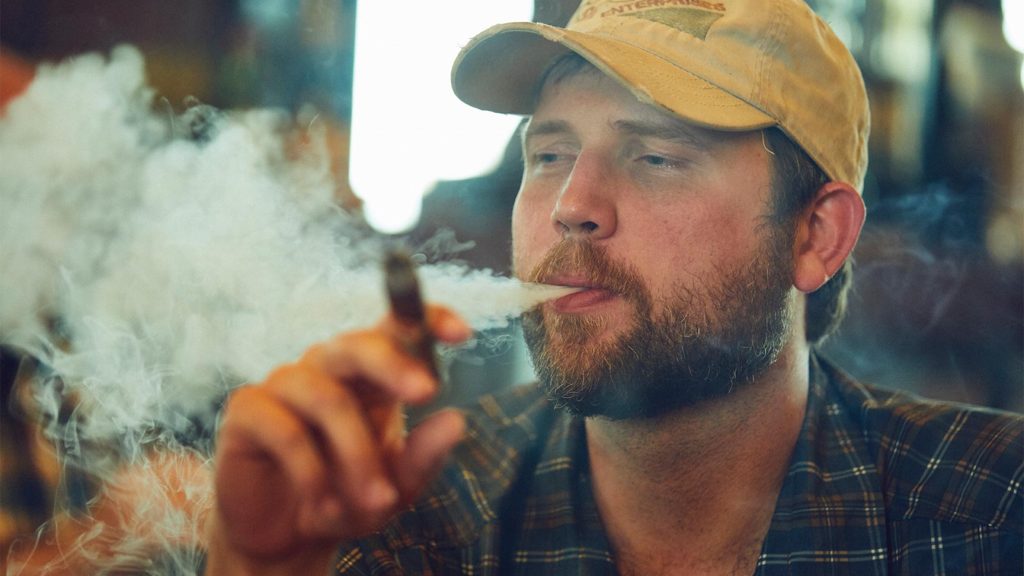
At 40 years old, The Nostalgia Shop is older than many fine cigars, and throughout its storied history, the address and offerings of this destination point have changed. George and his business partner, Tim Flynn, whom he worked with until 2010, originally opened an antique boutique in Rocheport under the moniker Stone Swan, and after five years, they moved to downtown Columbia, reopening as The Nostalgia Shop. There they stayed for nearly 30 years before George and his wife, Mariel, decided on a more favorable location in the south end of the city.
The Liggetts opened the joint venture of The Nostalgia Shop and a restaurant, Grand Cru, on New Year’s Eve, 1999. “We opened it up as a cigar society that served really good food — but the main interest was cigars,” George says. For eight years, the restaurant and shop ran harmoniously, but in 2008, the city’s new non-smoking ordinance changed things. “That really destroyed the whole thesis of this restaurant,” George says. “Our restaurant did take a hit after that law was put into place. . . . that’s why we were there — we were a cigar society.”
The new law meant changes had to be made. The Liggetts completely closed off the smoking section of the restaurant, creating two separate spaces, the restaurant and the cigar lounge. Today, that’s how it still operates. Two couches and a few tables welcome guests. Art, in the form of framed vintage cigar wrappers, signed posters, and stacks of cigar boxes, furnish the room. It’s a place designed for patrons to “relax and smoke a good cigar,” Mariel says. High-end filtration systems run on a loop, purifying the air. “I‘ve had 30 to 40 people in here, and four or five hours after they leave, the room’s clean again as long as those things are on,” George says.
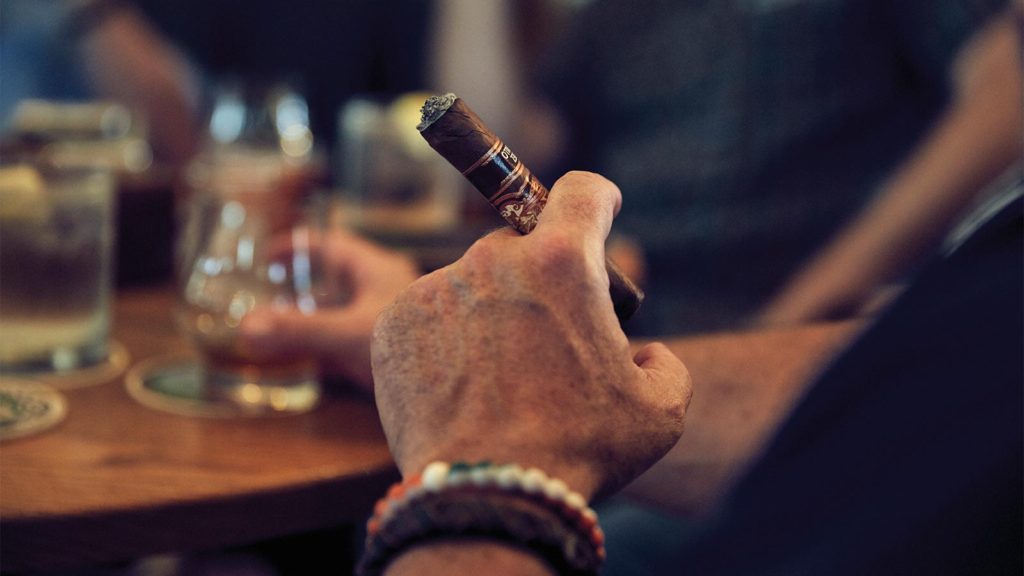
A Hobby, Not a Habit
As George leans in to relight his cigar, the flame exposes a faint black eye and pink cheek. “I didn’t really beat him up,” Mariel assures me. “He had dental surgery.” One of the stipulations of his recovery was a tobacco-free week. He did it with ease, which, surprisingly, is not uncommon for the man who spends every evening entertaining guests in his smoke shop.
The Liggetts both enjoy an intermittent puff of fine tobacco, but as they’ll tell you, they don’t have to have it. “It’s a hobby, not a habit,” Mariel says. “Every week we’re closed on Sundays. He goes home Saturday night and at home he doesn’t smoke on Sundays.” The habit-forming cigarettes differ in many ways from cigars, including in their proper form of smoking. “Cigarette smokers make the worst cigar smokers,” Mariel says. “You don’t inhale cigar smoke. You want to leave it in your taste buds.”
Most of the hobby smokers who frequent the shop are male. “This just seeps masculinity,” he says, gesturing at the shelves lined with bourbon, scotch, and cigars. Though the shop does have a masculine air, he doesn’t ever forget about his female clientele. “Not only do they smoke themselves, but they’re always buying for somebody,” he says. “A lot of ladies are really into it.”
Groups dining in the restaurant often mosey over to the cigar lounge following dinner for a smoke and their favorite spirit. Cigar groups meet weekly, and the most dedicated patrons have rented cigar boxes in George’s walk-in humidor, where they’re kept locked up tight and as fresh as possible. “That’s for the very serious smoker,” George says. “All of the spaces are rented, and they always are. When one comes up, there’s a waiting list.”
Passersby, like one recent traveler from the East Coast, sometimes stop in for a single high-end stogie to-go. “He was from New Jersey; first time he’d ever been to the Midwest,” George says of a walk-in customer. “He’s only here for a meeting. He’s leaving tomorrow morning. Just looking for a place to buy a cigar.” Whichever group you fall into, even if it’s the never-smoked-anything club, George will treat you like an old friend.
He’s made many friends over the course of the half century he’s been in business, including the Rombauers, of “The Joy of Cooking” fame and of Rombauer Vineyards in Napa Valley. The Liggetts and Rombauers built a friendship over wine, and when matriarch Joan Rombauer was diagnosed with pancreatic cancer, the two families teamed up to host fundraisers in support of cancer research.
“We partnered with the Gurucharri Foundation and hosted dinners,” Mariel says. “KR [Koerner Rombauer Jr.] would come from California and he would walk people through dinner and the wines. He said, ‘Anything I can do for pancreatic cancer research.’” As Mariel tells it, Joan and KR were on opposite ends of the cigar spectrum. “Joan would say ,‘No cigars!’ and KR whispered, ‘I’ll take a cigar.’” After Joan’s passing in 2002, the Liggetts named their meeting room The Rombauer Room in her honor.
George has more stories to tell about his time in the business — too many for these pages, but plenty to share over a smoke. Stop in and meet the shop mascot, Layla, light up a cigar on the antique lighter, and then ask George about the death on the dance floor, his fowl friend Jeremy, or how he learned to make his way through a late-night Chicago road block. Chances are, you’ll leave his shop with a grand feeling of nostalgia.
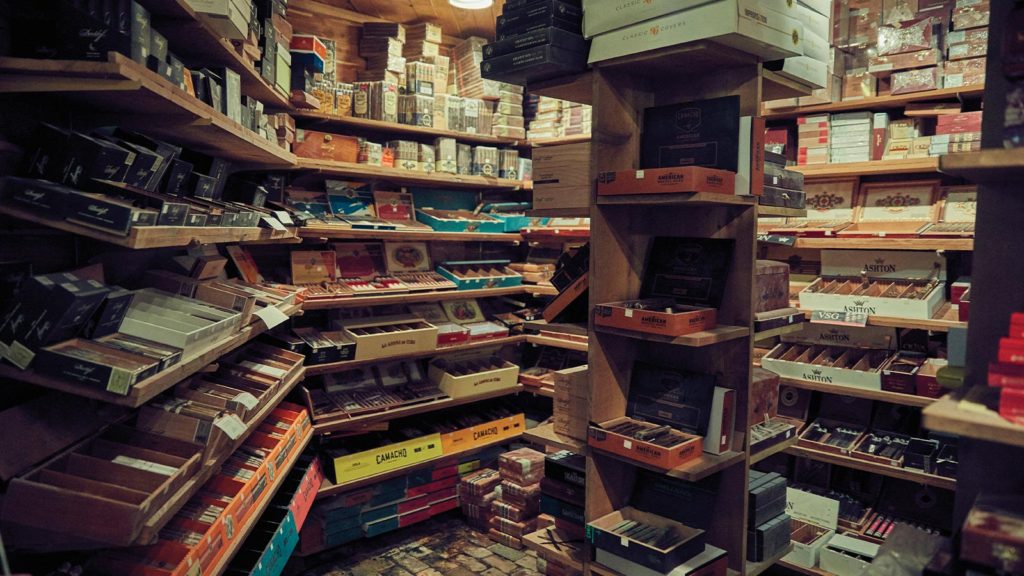
The Anatomy of a Cigar
George Liggett is an expert tobacconist. Here, breaks down each step of the cigar-making process.
Three parts to tobacco:
Filler: a big bundle of tobacco.
Binder: holds it together.
Wrapper: One little tiny piece of tobacco—that’s 80% of flavor, he says.
“But first, you’ve got to get a seed and put that in the ground. Then they harvest the leaves, then age them. They put it in big bales, and it has to be in that bale for approximately five years, and rotated every six weeks. Most cigars are five years old — if they do rush them, they’re no good.
“All cigars are blended; they’ve always got three different kinds of tobacco. The essence is when all three come together in one flavor. That’s the mark of a great cigar. If they don’t, the taste of the filler overwhelms everything. You don’t want that. You want to get it down to where it marries together, tasting more wrapper than anything. That’s why it has to sit.
“It’s an old-fashioned method of preparation. Just takes time. A good bottle of bourbon would be 10 to 15 years old. Wine’s the same way. Time is everything, especially in tobacco. When you realize how good a cigar is, this is all part of the process. So when I see somebody get a very good cigar, take a couple puffs, and put it out, that’s 10 to 12 years gone.
“You can relight a cigar as many times as you want, you can leave it overnight, it’s still going to be there until it dries out. That’s the humidity factor—without the humidity, you’re out of business, it tastes like straw.”


